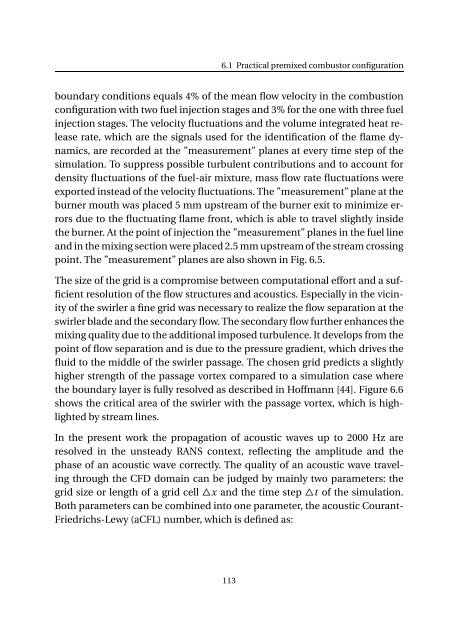Impact of fuel supply impedance and fuel staging on gas turbine ...
Impact of fuel supply impedance and fuel staging on gas turbine ...
Impact of fuel supply impedance and fuel staging on gas turbine ...
Create successful ePaper yourself
Turn your PDF publications into a flip-book with our unique Google optimized e-Paper software.
6.1 Practical premixed combustor c<strong>on</strong>figurati<strong>on</strong><br />
boundary c<strong>on</strong>diti<strong>on</strong>s equals 4% <str<strong>on</strong>g>of</str<strong>on</strong>g> the mean flow velocity in the combusti<strong>on</strong><br />
c<strong>on</strong>figurati<strong>on</strong> with two <str<strong>on</strong>g>fuel</str<strong>on</strong>g> injecti<strong>on</strong> stages <str<strong>on</strong>g>and</str<strong>on</strong>g> 3% for the <strong>on</strong>e with three <str<strong>on</strong>g>fuel</str<strong>on</strong>g><br />
injecti<strong>on</strong> stages. The velocity fluctuati<strong>on</strong>s <str<strong>on</strong>g>and</str<strong>on</strong>g> the volume integrated heat release<br />
rate, which are the signals used for the identificati<strong>on</strong> <str<strong>on</strong>g>of</str<strong>on</strong>g> the flame dynamics,<br />
are recorded at the ”measurement” planes at every time step <str<strong>on</strong>g>of</str<strong>on</strong>g> the<br />
simulati<strong>on</strong>. To suppress possible turbulent c<strong>on</strong>tributi<strong>on</strong>s <str<strong>on</strong>g>and</str<strong>on</strong>g> to account for<br />
density fluctuati<strong>on</strong>s <str<strong>on</strong>g>of</str<strong>on</strong>g> the <str<strong>on</strong>g>fuel</str<strong>on</strong>g>-air mixture, mass flow rate fluctuati<strong>on</strong>s were<br />
exported instead <str<strong>on</strong>g>of</str<strong>on</strong>g> the velocity fluctuati<strong>on</strong>s. The ”measurement” plane at the<br />
burner mouth was placed 5 mm upstream <str<strong>on</strong>g>of</str<strong>on</strong>g> the burner exit to minimize errors<br />
due to the fluctuating flame fr<strong>on</strong>t, which is able to travel slightly inside<br />
the burner. At the point <str<strong>on</strong>g>of</str<strong>on</strong>g> injecti<strong>on</strong> the ”measurement” planes in the <str<strong>on</strong>g>fuel</str<strong>on</strong>g> line<br />
<str<strong>on</strong>g>and</str<strong>on</strong>g> in the mixing secti<strong>on</strong> were placed 2.5 mm upstream <str<strong>on</strong>g>of</str<strong>on</strong>g> the stream crossing<br />
point. The ”measurement” planes are also shown in Fig. 6.5.<br />
The size <str<strong>on</strong>g>of</str<strong>on</strong>g> the grid is a compromise between computati<strong>on</strong>al effort <str<strong>on</strong>g>and</str<strong>on</strong>g> a sufficient<br />
resoluti<strong>on</strong> <str<strong>on</strong>g>of</str<strong>on</strong>g> the flow structures <str<strong>on</strong>g>and</str<strong>on</strong>g> acoustics. Especially in the vicinity<br />
<str<strong>on</strong>g>of</str<strong>on</strong>g> the swirler a fine grid was necessary to realize the flow separati<strong>on</strong> at the<br />
swirler blade <str<strong>on</strong>g>and</str<strong>on</strong>g> the sec<strong>on</strong>dary flow. The sec<strong>on</strong>dary flow further enhances the<br />
mixing quality due to the additi<strong>on</strong>al imposed turbulence. It develops from the<br />
point <str<strong>on</strong>g>of</str<strong>on</strong>g> flow separati<strong>on</strong> <str<strong>on</strong>g>and</str<strong>on</strong>g> is due to the pressure gradient, which drives the<br />
fluid to the middle <str<strong>on</strong>g>of</str<strong>on</strong>g> the swirler passage. The chosen grid predicts a slightly<br />
higher strength <str<strong>on</strong>g>of</str<strong>on</strong>g> the passage vortex compared to a simulati<strong>on</strong> case where<br />
the boundary layer is fully resolved as described in H<str<strong>on</strong>g>of</str<strong>on</strong>g>fmann [44]. Figure 6.6<br />
shows the critical area <str<strong>on</strong>g>of</str<strong>on</strong>g> the swirler with the passage vortex, which is highlighted<br />
by stream lines.<br />
In the present work the propagati<strong>on</strong> <str<strong>on</strong>g>of</str<strong>on</strong>g> acoustic waves up to 2000 Hz are<br />
resolved in the unsteady RANS c<strong>on</strong>text, reflecting the amplitude <str<strong>on</strong>g>and</str<strong>on</strong>g> the<br />
phase <str<strong>on</strong>g>of</str<strong>on</strong>g> an acoustic wave correctly. The quality <str<strong>on</strong>g>of</str<strong>on</strong>g> an acoustic wave traveling<br />
through the CFD domain can be judged by mainly two parameters: the<br />
grid size or length <str<strong>on</strong>g>of</str<strong>on</strong>g> a grid cell △x <str<strong>on</strong>g>and</str<strong>on</strong>g> the time step △t <str<strong>on</strong>g>of</str<strong>on</strong>g> the simulati<strong>on</strong>.<br />
Both parameters can be combined into <strong>on</strong>e parameter, the acoustic Courant-<br />
Friedrichs-Lewy (aCFL) number, which is defined as:<br />
113
















